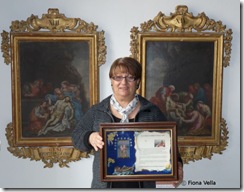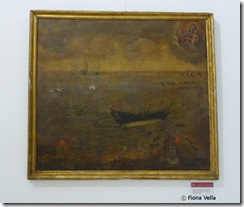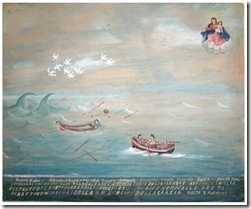Posts Tagged ‘Zabbar’
-
THE SELLING GAME
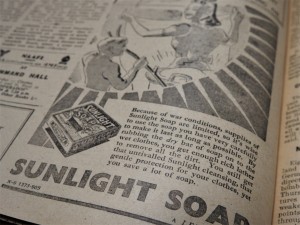 Advertising is said to reflect the societal tastes, beliefs and norms. By looking back at the adverts that were published in the Times of Malta at the end of the years 1939 to 1944, this becomes very clear. Yet even their absence during the days of war have much to say.
Advertising is said to reflect the societal tastes, beliefs and norms. By looking back at the adverts that were published in the Times of Malta at the end of the years 1939 to 1944, this becomes very clear. Yet even their absence during the days of war have much to say.There are whole studies and much research behind advertising. Adverts are used as a form of communication intended to convince an audience to purchase or take some action upon products, ideals or services. Their regularity aim to impact on memory to create a sense of familiarity and trust to buy those products.
Indeed, while turning the pages of November – December 1939 and 1940 of the Times of Malta, it is evident that a group of particular brands are always featuring. Most relate to health, beauty, alcohol, insurance, entertainment (mainly cinema), fashion and gifts.
Health adverts at the time generally focus on irritability of the stomach, laxatives, cold and fever, rheumatism, eczema, fatigue and sleeplessness. The message on the adverts is mainly delivered through drawings and long descriptions about the benefits of using the products.
 The text is generally presented in the form of a conversation – “Why continue to be agonised by Terrible Headaches, Niggling Nerve Pains, Black Depression, and Heavy-Limbed Lassitude?” – reads the introduction of an advert for tonic tablets.
The text is generally presented in the form of a conversation – “Why continue to be agonised by Terrible Headaches, Niggling Nerve Pains, Black Depression, and Heavy-Limbed Lassitude?” – reads the introduction of an advert for tonic tablets.“Do you realise the danger? Impure blood causes disease.” – says another advert selling a ‘blood mixture’ as ailment against rheumatism, lumbago, eczema, boils and pimples.
Communication with the readers is stark and direct – The word “Poisoned!” in capital black letters runs over the mouth of a man in the advert of a toothpaste. “Pyorrhoea has robbed him of his teeth, poisoned his whole system. Don’t let this happen to you.”
“Is running a house too much for you?” reads the title of an energy drink. “Do you feel that the cares of the household get you down and managing your servants is a strain?”
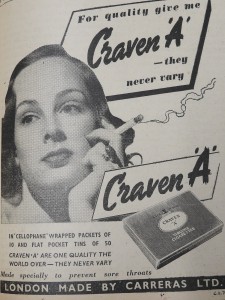 The quantity of adverts focusing on health issues form quite a big chunk of the advertising at the time. However, ironically, these are accompanied by cigarette adverts, one of which shows a beautiful young woman with a cigarette in her hand. A section of the advert text reads – “Made specially to prevent sore throats.”
The quantity of adverts focusing on health issues form quite a big chunk of the advertising at the time. However, ironically, these are accompanied by cigarette adverts, one of which shows a beautiful young woman with a cigarette in her hand. A section of the advert text reads – “Made specially to prevent sore throats.”Some of the adverts published at the time will certainly be unacceptable nowadays. Social class differences, sexism and offensive messages are quite typical.
“Women who belong to the 1st sleep group never grow old before their time. There are 3 groups. Which do you belong to?” – asks an advert selling Horlicks. “Most attractive women belong to the 1st sleep group.” – states another one. “Men who are sure of themselves belong to the 1st sleep group.” – and – “Men who get on in life nearly all belong to the 1st sleep group”.
 “Don’t look old! Tint those grey hairs with Shadeine.” – jumps at you an advert selling hair colour.
“Don’t look old! Tint those grey hairs with Shadeine.” – jumps at you an advert selling hair colour.Advertisements can influence strongly how we perceive things around us. By showing a high social class user of a product, the advert creates a longing or a pressure to purchase that item in order to belong to that level of society.
A skin-vitamin cream portrays the drawing of a beautiful lady, all dressed up in perfect make-up, set-up hair, a pair of lovely earrings and a crown. – “Lady Grenfell is one of the most beautiful among the young marrieds in Society…. She tells us, ‘I’m using Pond’s Creams containing the ‘skin-vitamin’, and they’re really amazing.”
“Many army and royal navy officers enjoy the comfort of our hand-made footwear. Why Not you? Sir.” – entices an advert showing the drawing of a highly elegant man sitting in a luxurious armchair while a shoe-maker sits on a stool to help him try on a new pair of shiny “Best English leather”.
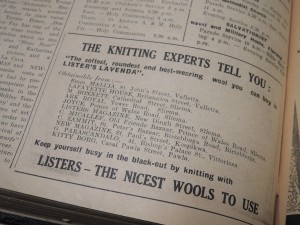 A shade of the effects of the Second World War, even though not yet happening in Malta is already present in adverts of 1939.
A shade of the effects of the Second World War, even though not yet happening in Malta is already present in adverts of 1939.“Keep yourself busy in the black-out by knitting with Listers – the nicest wool to use.” – advices an advert. “Bernards suggest that you give sensible gifts this Christmas. Such gifts as shirts, pyjamas, handkerchiefs, ties, socks, gloves and wool-slipovers all make very acceptable presents.” – recommends another one.
Not only adverts diminish in 1941 during the war days in Malta. Even the newspaper itself shrivels to a few pages although being published daily.
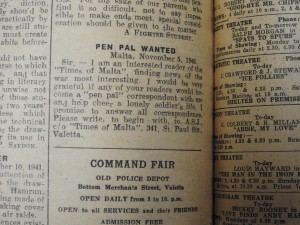 “Test your gas mask. Gas Chamber at Castile Place today.” – reads a warning advert on the front page of the Times of Malta on Tuesday, November 4, 1941. “There is no better way of ensuring that the respirator is still properly functioning than by putting it on and entering the gas chamber.”
“Test your gas mask. Gas Chamber at Castile Place today.” – reads a warning advert on the front page of the Times of Malta on Tuesday, November 4, 1941. “There is no better way of ensuring that the respirator is still properly functioning than by putting it on and entering the gas chamber.”Amid the difficulties of war, an advert speaks out the request for a pen pal – “I am an interested reader of the “Times of Malta”, finding news of the war most interesting. I would be very grateful if any of your readers would become a “pen pal” correspondent with me and help cheer a lonely soldier’s life.”
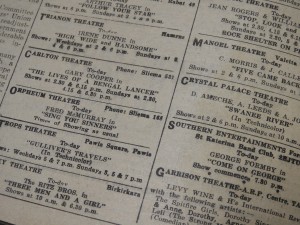 A considerable decrease of adverts continues in 1942. Alcohol adverts drop out completely. Cinema continues regularly in the following theatres – Manoel and Coliseum in Valletta, Gaiety, Majestic, Carlton and Orpheum in Sliema, Odeon, Thrianon and Rex in Ħamrun, Prince in Birkirkara, Buckingham and Royal in Żabbar, and Empire in Paola.
A considerable decrease of adverts continues in 1942. Alcohol adverts drop out completely. Cinema continues regularly in the following theatres – Manoel and Coliseum in Valletta, Gaiety, Majestic, Carlton and Orpheum in Sliema, Odeon, Thrianon and Rex in Ħamrun, Prince in Birkirkara, Buckingham and Royal in Żabbar, and Empire in Paola.“What do I do…. about the black market?” runs an advert issued by the Information Office. A Wartime Reminder advert issued by the same Office reminds people that “Imported Fuel is used for pumping Water. Reduced consumption of water saves Fuel. A saving in Fuel saves Freight, (and) Saving in freight helps to win the War.”
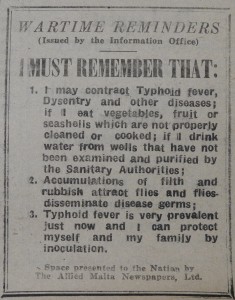 Another Wartime Reminder recommends the adequate washing of vegetables, fruit and seashells, and their proper cooking while warning against the accumulation of filth, since these may lead to Typhoid fever and Dysentry. Inoculation against the Typhoid fever is also advocated.
Another Wartime Reminder recommends the adequate washing of vegetables, fruit and seashells, and their proper cooking while warning against the accumulation of filth, since these may lead to Typhoid fever and Dysentry. Inoculation against the Typhoid fever is also advocated.The siege on the Maltese Islands effectively ended in November 1942. Yet adverts show that life took time to return to normal especially since the Second World War had not yet ended in other countries.
An advert issued by the N.F.U advices to eat cabbage and cauliflower to keep fit. Another advert informs its clientele that “Because of war conditions, supplies of Sunlight Soap are limited, so it’s wise to use the soap you have very carefully to make it last as long as possible.”
Even tennis balls were restored instead of purchasing new ones – “Hand in your old Tennis Balls to any of the Sports Dealers named below, who will forward them to Slazengers for renovation by a special process which includes reinflation and provision of a new outside cover.”
During the days of war, a few selected companies such as Bovril, managed to stay in the public eye through advertisements. “Makes all the difference between bread and butter.” The Bovril advert states. “A 4-oz. Bottle of Bovril makes over 100 delicious sandwiches.”
 Other adverts such as the one for Dettol portrayed the company’s involvement in the war efforts and reminded that the product should be used with “measured care” in order to keep the supply flowing.
Other adverts such as the one for Dettol portrayed the company’s involvement in the war efforts and reminded that the product should be used with “measured care” in order to keep the supply flowing.Marketers have always adapted to changing business demands when it comes to creating new advertisements. However, there are moments when their creativity is quite shocking – “Imitating Hitler” screams the title in bold capital letters of the British American Dry Cleaning Co.
(This feature was published in the Christmas Supplement issued with the Times of Malta dated 1st December 2019)
-
Long shell life
 Although during the Christmas season, it is customary to see statues of baby Jesus in a manger or in a crib, in Candice Fava’s shop New EGGsperience, the holy child would be seen resting in a decorated eggshell.
Although during the Christmas season, it is customary to see statues of baby Jesus in a manger or in a crib, in Candice Fava’s shop New EGGsperience, the holy child would be seen resting in a decorated eggshell.“I love to create unique hand-made objects and this craft of eggshell decoration has provided me with the opportunity to have my own niche market,” Fava explains.
Fava was raised on a farm in Australia, where her family sold eggs. They had several clients but one particular client intrigued Fava since she regularly purchased a substantial quantity of eggs.
“One day I decided to ask her why she always needed so many eggs and she promised that the next time she called at our farm, she would bring me a gift to show me. I felt deeply curious and I awaited her next visit with much anticipation. Eventually, she brought me a little jewel box adorned with lovely fabrics and accessories. I could not believe that she had actually made it with one of the eggs from our farm!”
 Fava was so fascinated with this idea that she decided to learn this craft. At the farm, she had all the eggs that she required and in time she learnt how to clean them without breaking them. Soon, she was producing her own eggshell decorations.
Fava was so fascinated with this idea that she decided to learn this craft. At the farm, she had all the eggs that she required and in time she learnt how to clean them without breaking them. Soon, she was producing her own eggshell decorations.“The first item I made was a jewel box which I painted with bright nail polish. I was so delighted when I saw it ready! Today I realize that it wasn’t much but it is still very dear to me as it reminds me from where it all started.”
Along the years, eggshell decoration became an integral part of Fava’s life. Which explains why she was surprised when she came over to Malta and realized that this craft was totally unknown on the island.
“It was hard at first to find the necessary materials to work with. However, my husband Ivan helped me to locate some local farms which could provide me with eggs. He also assisted me in the cleaning and sterilization of the eggshells.”
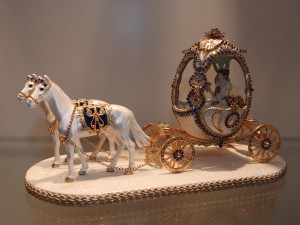 Initially she decorated eggshells for her personal enjoyment. Then she began to give them out as gifts to her friends.
Initially she decorated eggshells for her personal enjoyment. Then she began to give them out as gifts to her friends.“My friends were delighted with these eggshell decorations since they had never seen anything like them before. Soon they were asking me to make some more creations for them so that they could give them as presents to others. It was only a matter of time until I confirmed that there was a demand for such products.”
Ultimately, people’s positive reactions to her craft led her to open her own shop in Zabbar.
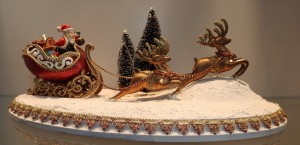 “By then, I had produced so many various eggshell decorations that I had no difficulty to fill the shop with my creations. Each time that new clients come in, it is charming to see their incredulity that so many exquisite things can be made from common fragile eggshells.”
“By then, I had produced so many various eggshell decorations that I had no difficulty to fill the shop with my creations. Each time that new clients come in, it is charming to see their incredulity that so many exquisite things can be made from common fragile eggshells.”Nowadays, the Favas have located foreign suppliers who are able to furnish them with quantities of ready-made cleaned and sterilized eggshells. Moreover, they have also managed to establish contacts with suppliers of other materials with which the eggshells are decorated.
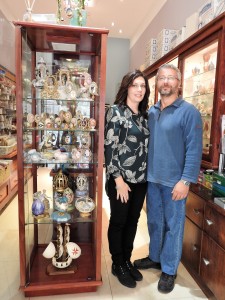 “My husband supports me a lot and helps me to come out with new ideas. Along the years, he too became enthusiastic about this work and now he is able to make his own creations.”
“My husband supports me a lot and helps me to come out with new ideas. Along the years, he too became enthusiastic about this work and now he is able to make his own creations.”A wide range of differently decorated eggshells which are ideal as gifts for various occasions are displayed at their shop. However, a few of them are not for sale.
“When we join forces, we create the best decorations,” the two agree. “The collaboration of ideas lead to exclusive objects which become difficult to part from. Some of them, such as the lamp shade, the handbag set and the sea vessel, are cherished objects and we have won prestigious awards for them at local national craft competitions. Such works provide us also with the opportunity to combine different materials and crafts like woodwork and eggshell decoration. Our imagination has no limit, however we are restrained with the eggshells’ curvatures, although we take that as part of the challenge.”
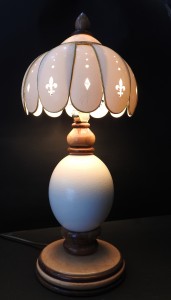 Even though all of the creations may serve as decorations, some of them also have their own practical use, acting as exotic containers, wearable accessories or light fittings.
Even though all of the creations may serve as decorations, some of them also have their own practical use, acting as exotic containers, wearable accessories or light fittings.“Besides selling our creations from my shop, I also participate in several fairs and exhibitions and therefore more people are getting to know about this craft. Presently I am also taking part in the program Niskata which airs on TVM. Yet there is still much more to do to create more awareness.”
“It is great to see how far a simple hobby can take you. Little by little, all my family has become involved in this craft. In fact, my daughter is already coming up with her own designs and creations and my little son is showing interest too.”
In these last years, Fava has also dedicated herself to teach this craft to all those who are interested, both children and adults. She has also furnished her shop with all the necessary materials including eggshells of various sizes, cut eggshells, acrylic paints, stands, bases and a multitude of other items.
As Christmas time approaches, the two explore the possibility of new designs and ideas in order to come out with original creations which relate to this theme.
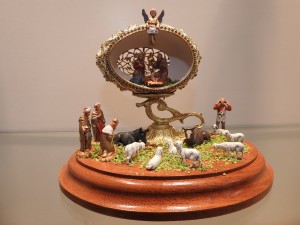 “We are always dreaming of what we are going to do next. We work with all sorts of eggshells, starting with the smallest ones of love-birds and parrots, and moving on to larger ones such as those of pigeons, quails, ducks, geese, emu, rhea and ostrich. The geese’s eggs are the most practical because of their size and shape. Other eggs are relished for their natural particular characteristics such as the blackish colour of the rhea eggs and the large shape and pearly shade of the ostrich eggs.”
“We are always dreaming of what we are going to do next. We work with all sorts of eggshells, starting with the smallest ones of love-birds and parrots, and moving on to larger ones such as those of pigeons, quails, ducks, geese, emu, rhea and ostrich. The geese’s eggs are the most practical because of their size and shape. Other eggs are relished for their natural particular characteristics such as the blackish colour of the rhea eggs and the large shape and pearly shade of the ostrich eggs.”“Christmas brings a lot of joy and memories. This festive season opens up a whole new world to create related items with baby Jesus statues, cribs, angels, Father Christmas, reindeers, sparkles and a whole range of bright colours. We love to reflect the warm meaning of Christmas in our works.”
-
IF THESE WALLS COULD TALK
450 years ago, the Maltese Islands were in the spotlight of several European sovereigns after they had succeeded to come out victorious from the massive siege that was laid upon them by the powerful Ottoman Empire. Fort St Elmo lay in ruins and the other fortifications and houses which had been targeted by the enemy were in no better shape. The land still seeped in the blood of the thousands who had lost their lives during the fighting, whilst many others remained maimed.
Amid this devastation, the eminence of the surviving Knights of the Order of St John surged, and their fame reached legendary proportions. Letters of congratulations which they received from all over Europe, uplifted their spirits, whilst generous donations eventually helped them to build the new city of Valletta.
The Knights of St John continued to rule the Maltese Islands until 1798, when they were ousted by French Military General, Napoleon Bonaparte. Although, some might believe that at this time, the Order was obliterated, in reality, these mythical Hospitallers are still present amongst us, and are as real as ever.
The Russian Grand Priory of Malta
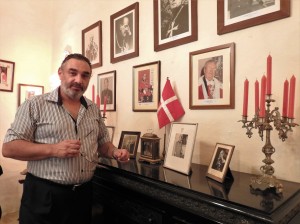 Since the early years of the Hospitallers’ foundation by Blessed Gerard, the Order protected the faithful and provided aid to the sick and poor. These elements have always remained deeply rooted in the mission of the knights who followed throughout the centuries.
Since the early years of the Hospitallers’ foundation by Blessed Gerard, the Order protected the faithful and provided aid to the sick and poor. These elements have always remained deeply rooted in the mission of the knights who followed throughout the centuries.“Even today, as Knights and Dames of the Russian Grand Priory of Malta who form part of the Order of St John of Jerusalem, Knights Hospitallers, under the constitution of the late King Peter II of Yugoslavia, we strive to continue to live up to our motto “Pro Fide, Pro Utilitate Hominum,” declared Chev. Saviour Garcia as we stood in front of a large painting of Blessed Gerard at Palazzino Sapienti in Valletta.
“Today, the Order’s mission still incorporates the duty to profess the Christian faith. However, its present members are not fighters but humanitarians who swear to act for the common good of all people without distinction of race or religion.”
Garcia outlined a number of philantropic projects which the Russian Grand Priory of Malta have been taking care of without much pomposity. Amongst these he mentioned St Joseph’s Residential Home for children in Żabbar, Dar Nazareth’s Residential Home for people with disability in Żejtun, and the construction of a hospital and a hostel in Thailand which caters for the needs of dying children with AIDS.
“The first investiture and the official institution of The Malta Priory took place on March 8, 1964. A few days after, His Majesty King Peter II of Yugoslavia legitimized the Order by giving it a new Constitution to meet 20th century demands. Within the first decades of its existence, The Malta Priory made several notable achievements which ultimately led it to be elevated to Grand Priory by Royal Warrant from King Peter II on Feb 22, 1970. This Royal Warrant gave our Grand Priory the name of Russian Grand Priory of Malta.”
Palazzino Sapienti, Valletta
 Interestingly, it was the same king who donated the sum of 1000 dollars in order to open a fund for the purchase of a large house which was expected to serve as the World Head Quarters of this Order. The choice fell on the prestigious Palazzino Sapienti which today is located at 223, St Paul Street, Valletta, right opposite to the University of Malta Valletta Campus.
Interestingly, it was the same king who donated the sum of 1000 dollars in order to open a fund for the purchase of a large house which was expected to serve as the World Head Quarters of this Order. The choice fell on the prestigious Palazzino Sapienti which today is located at 223, St Paul Street, Valletta, right opposite to the University of Malta Valletta Campus.An original letter held at the archives of Palazzino Sapienti that was sent to Czar Paul I by Grand Master Hompesch in 1797, indicates that at the time, the Russians had an interest to involve themselves in the Order. That is why, after the Knights of St John were expelled from Malta, some of them opted to find refuge in St Petersburg, where they elected the Russian Emperor, Paul I, as their Grand Master, thereby replacing Ferdinand von Hompesch who was then held in disgrace and had to abdicate in 1799.
Prior to its present distinguished function, Palazzino Sapienti had its fair share of interesting history.
“Whilst researching about the origins of this building, I discovered that its construction was commissioned in the late 16th century by the English Grand Prior of the Order of St. John, Sir Richard Shelley. However, he did not have the opportunity to enjoy his residence for long, since he got into disagreement with the Inquisitor after he failed to present to him his correspondence to the Protestant Queen Elizabeth for censorship, as was the regulation at the time. Soon, matters got worse when Shelley had also a dispute with Grand Master Peter del Monte, and in a diplomatic way, this building was taken away from him after he was offered another property. Instead, Palazzino Sapienti became the residence of Fra Nicolo Sollima, the Collegium Melitense Rector,” revealed Garcia.
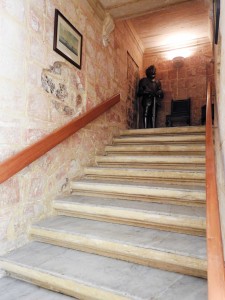 “Stone used for the building of the house was quarried on site. Once the building was complete, the resultant small quarry was used as a water cistern and basement. This process of cutting stones directly from Monte Sciberras hurried the process of the building of the new city.”
“Stone used for the building of the house was quarried on site. Once the building was complete, the resultant small quarry was used as a water cistern and basement. This process of cutting stones directly from Monte Sciberras hurried the process of the building of the new city.”“The facade of the palazzino was imposing, having a main door flanked by two others. The main entrance was decorated by a barrel vaulted ceiling, typical of the 16th century. Traces of a blocked arch located under the staircase which leads up to the piano nobile points out that originally, the level of the street was lower than it is today.”
“On 12th September 1634, a gunpowder magazine located in the whereabouts of the palazzino, blew up, killing 33 persons. The devastated site was left abandoned for thirty years until Grand Master Nicholas Cotoner established the Fondazione Cotoner in order to rebuild the houses in Strada San Paolo. The palazzino had suffered some cracks in the walls and its glass windows were shattered. Some structural changes were done to it, however, this structure was never intended to be built higher than two floors, since it would have been higher than the opposite building and would have cast a shadow on the University’s sundial.”
“Traces of red paint on the walls show that this building was painted in this colour. Meanwhile, the limestone balcony supports, the internal courtyard and the main staircase were adorned with seashell carvings that represented St John the Baptist, the patron saint of the Order of St. John. The seashell is also representative of the water element, in this case creativity and knowledge, as befits the University Rector’s house.”
It was a pleasure to explore this palazzino which I had never visited before. In the meantime, Garcia recounted some curiosities about the notable tenents who lived there.
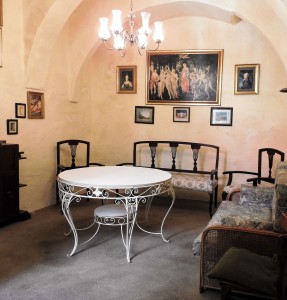 “In 1919, the tenant of Palazzino Sapienti was the lawyer Luigi Camilleri. On 7th June, 1919, Prince Lobanov-Rostovsky and Count Andrey Bobrinsky, both Russian Imperial refugees, were visiting Camilleri at his residence when suddenly the ‘Sette Guigno’ riots broke out. A large crowd made its way to the Royal Malta University and started to attack it, tearing down the English Imperial flag. These two Russian nobles who were witnessing this from the opposite palazzino were scared stiff since the remembrance of the Bolshevik revolution still haunted them. They stayed at the premises till the 12th June when they were escorted back to San Anton Palace in Balzan by Police Superintendent James Frendo Cumbo.”
“In 1919, the tenant of Palazzino Sapienti was the lawyer Luigi Camilleri. On 7th June, 1919, Prince Lobanov-Rostovsky and Count Andrey Bobrinsky, both Russian Imperial refugees, were visiting Camilleri at his residence when suddenly the ‘Sette Guigno’ riots broke out. A large crowd made its way to the Royal Malta University and started to attack it, tearing down the English Imperial flag. These two Russian nobles who were witnessing this from the opposite palazzino were scared stiff since the remembrance of the Bolshevik revolution still haunted them. They stayed at the premises till the 12th June when they were escorted back to San Anton Palace in Balzan by Police Superintendent James Frendo Cumbo.”“During the Second World War, the premises were used by the British Royal Air Force for the decoding of enemy aerial operations. Palazzino Sapienti survived two enemy bombs which were dropped in the vicinity. Yet tragedy still struck this place when two children, who were attending school in this building after the Valletta school was hit, found their way down a spiral staircase which led to the city’s undergrounds and got lost there. No one ever found them and these stairs have been blocked ever since.”
 Today, this building is also proud to possess three saint reliquaries: a first degree bone fragment from the Order’s Patron Saint St. John the Baptist, and two third degree relics in the form of a throne chair on which St. John Paul II sat during one of his Papal visits to Italy, and a hand signed dedication by Sister Mother Theresa of Calcutta who was also a member of the Order.
Today, this building is also proud to possess three saint reliquaries: a first degree bone fragment from the Order’s Patron Saint St. John the Baptist, and two third degree relics in the form of a throne chair on which St. John Paul II sat during one of his Papal visits to Italy, and a hand signed dedication by Sister Mother Theresa of Calcutta who was also a member of the Order.“Besides housing the Seat of the Order of St John of Jerusalem, Knight Hospitaller, Palazzino Sapienti has now opened its doors to the public who might be interested to visit it. Moreover lectures regarding various subjects are organized inside one of its rooms wherein we are also giving the opportunity to university students who would like to present talks about their studies or thesis.”
Certainly, an invitation to such a prestigious, architectural, and historical gem, should not be missed.
(This article was published in ‘Focus Valletta’ Suppliment issued with The Times of Malta dated 30 September 2015)
-
Keeping the faith: ex-voto paintings
In the old days, the sea played a prominent role in peoples’ lives, especially to island inhabitants. It was a source of livelihood for fishermen, a fortuitous space for pirates, a bridge to other countries for travellers, merchants and diplomats, and a channel for soldiers from which to attack the enemy during war.
People were often moving on the sea on various types of vessels, constantly aware of the risk that this involved. They feared corsair attacks and the aggression of unknown dangerous species which could lurk in the waters’ depths. Yet none was worse than the actual possibility of experiencing a terrible storm where the sea turned into a formidable voracious colossus which could engulf whatever dared to be present during its deadly rage.
Meanwhile, it was a world where people in jeopardy were generally left to deal with their own fate, and ironically it was often faith which led to their survival. Historical sources describe how people created ingenious ways of dealing with these dangers by formulating different methods to guarantee a safer voyage, habitually intermingling religion with superstition. One of these practices in Malta involved the production of sacred coins which could be thrown into the sea to calm down the troubled waters. Indeed, sailors were urged to buy these coins which were made out of blessed white candle, a day before Easter, since failure to do so was believed to attract dreadful bad luck. On the other hand, local fishermen are known to have concocted a secret prayer which only the eldest of them knew and which only they could recite in order to shield their boat against the threat of bad weather.
Although hundreds of years have passed from these experiences, nowadays we still have the opportunity to witness the ordeal that our ancestors have gone through whilst being out at sea. Many of these testimonies are still present among us in the form of ex-voto paintings wherein devoted people have illustrated the eventful moments when they were about to die and their faith saved them. Sadly, though we have lost many of these ex-voto along the years, mainly due to improper storage and conservation methods, we still find various examples in numerous chapels, churches, sanctuaries and museums around our islands. Among these, one finds 183 maritime ex-voto in the sanctuary of Our Lady of Tal-Ħerba in Birkirkara, and another 64 in the sanctuary of Our Lady in Mellieħa.
Another interesting collection of such ex-voto is located in the Żabbar Sanctuary Museum. Unfortunately, from the original assortment of 300 maritime ex-voto, today only 85 remain. However, as Ġużeppi Theuma, the Secretary of the Żabbar Sanctuary Museum Commission has informed me, this museum is proud to possess the oldest maritime ex-voto on our islands which as yet is still undated. The next dated ex-voto in this collection goes back to 1631, as the information written on the painting clearly shows. Moreover, this particular ex-voto manifests the full interpretation of the initials V.F.G.A. which generally accompanies several of these paintings. These letters stand for Votum Fecit et Gratiam Accepit which translate in ‘a promise was made and the grace was given’.
Certainly, these ex-voto vary in style and artistry, since they cover various periods of time but also because they were donated by people from different levels of society wherein not all could afford to engage the best painters. Indeed, the acute details that one can observe in some of these works provide valuable information regarding the different type of vessels that were used along the years. Nevertheless all the ex-voto relate the same basic instinctive tendency of humans to turn to faith and to prayers especially when everything seems to be lost, and none other could help. An intriguing observation is that even when being on foreign seas, other than the Mediterranean and therefore far away from the mother-country, Maltese people and also the Knights of the Order which were based on our islands, generally directed their prayers to Our Lady, and particularly to one which they believed mostly in. In fact, this holy entity is clearly displayed in each of the ex-voto in order to show the viewers to whom the donator had prayed whilst being in trouble and who has saved his life. This act was meant as a thanksgiving but it was also intended to act as proof of the miraculous power of Our Lady and therefore to increase faith towards her.
Although the tradition of donating ex-voto has almost died out, it is interesting to note that this custom is still being practiced in our country. In fact, the most recent maritime ex-voto in the Żabbar Sanctuary Museum was donated by Carmen Axiaq on the 21st September 2012. Eager to understand the thought behind this act, I met Carmen at the museum wherein she explained to me the miserable and painful moments that she and her family have gone through when her husband Mario was lost at sea for two days after he got disoriented in the fog whilst fishing. As the search went on and days passed, the possibility of finding him alive started to fade and Carmen and her family were left with no hope except to turn to Our Lady and supplicate her intervention to assist Mario. While her daughter went on Dingli cliffs shouting out her father’s name in the fervent wish to do something to help, Carmen turned to Our Lady of Graces of the Żabbar Sanctuary and she asked her to use one of the twelve stars with which she is blessed in order to enlighten the way so that her husband could come back. Thankfully, Mario was found in time by the authorities and he was brought back to land safely. The family was overwhelmed with happiness but they did not forget who had helped them during their distress. Hence, together they composed an ex-voto wherein they narrated their story and adorned it with photos and hand-made decorations, so that whoever saw it could be reminded of the miracolous potential of prayer and of the greatness of Our Lady.
(This article was published in the Shipping and Logistics Supplement of the Times of Malta dated 5th March 2014)
-
CHRISTMAS EGGS
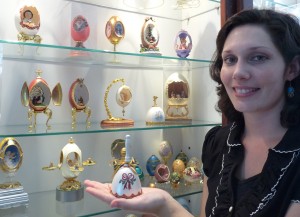 Natives watched eagerly with awe as the foreign traders unwrapped large ostrich eggs decorated with exotic painted designs. The Phoenician merchants were sure that the ornamented eggs will be sold out in a matter of minutes, for this race possessed the key to humanity’s heart – the ability to manipulate a sense of wonder. Centuries later this magic still lives … an ingenious craft which started far away in an Australian farm has recently been introduced to our islands by Candice Fava, whose artistry in egg decoration is a joy to behold.
Natives watched eagerly with awe as the foreign traders unwrapped large ostrich eggs decorated with exotic painted designs. The Phoenician merchants were sure that the ornamented eggs will be sold out in a matter of minutes, for this race possessed the key to humanity’s heart – the ability to manipulate a sense of wonder. Centuries later this magic still lives … an ingenious craft which started far away in an Australian farm has recently been introduced to our islands by Candice Fava, whose artistry in egg decoration is a joy to behold.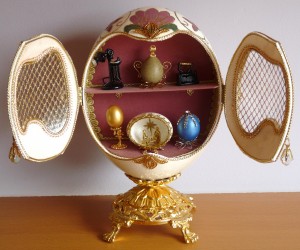 “I have fond memories of my childhood. My family lived in a farm in Australia from which we used to sell eggs. We had lots of clients but one particular client attracted my attention since she regularly purchased a substantial quantity of eggs. One day I decided to ask her why she always needed so many eggs and she promised that the next time she called at our farm, she will bring me a gift to show me. I felt deeply curious and I awaited her next visit with much anticipation. When she came she brought me a little jewel box adorned with lovely fabrics and accessories. I could not believe that she had actually made it with one of the eggs from our farm! It was such a fascinating idea that I made up my mind to learn this craft. I was blessed to have so much eggs to experiment upon and my mum urged me and gave me ideas to be creative. Eventually I succeeded to learn how to empty the eggs and clean them thoroughly without breaking them. The first item I made was a jewel box which I painted with a bright nail polish. I was so delighted when I saw it ready! Today I realize that it wasn’t much and I keep it hidden away. However it is very dear to me as it reminds me from where it all started.”
“I have fond memories of my childhood. My family lived in a farm in Australia from which we used to sell eggs. We had lots of clients but one particular client attracted my attention since she regularly purchased a substantial quantity of eggs. One day I decided to ask her why she always needed so many eggs and she promised that the next time she called at our farm, she will bring me a gift to show me. I felt deeply curious and I awaited her next visit with much anticipation. When she came she brought me a little jewel box adorned with lovely fabrics and accessories. I could not believe that she had actually made it with one of the eggs from our farm! It was such a fascinating idea that I made up my mind to learn this craft. I was blessed to have so much eggs to experiment upon and my mum urged me and gave me ideas to be creative. Eventually I succeeded to learn how to empty the eggs and clean them thoroughly without breaking them. The first item I made was a jewel box which I painted with a bright nail polish. I was so delighted when I saw it ready! Today I realize that it wasn’t much and I keep it hidden away. However it is very dear to me as it reminds me from where it all started.”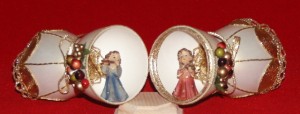 Looking at the variety of decorated eggs in her shop NewEggsperience in Żabbar, it was clear that Candice had learned the craft quite well. I surely found it hard to understand how she could carve out doors, windows, shelves and other designs from a simple egg-shell. And like the famous incredulous St Thomas, she had to allow me to hold an object in my hands in order to affirm that it was really made out of an egg.
Looking at the variety of decorated eggs in her shop NewEggsperience in Żabbar, it was clear that Candice had learned the craft quite well. I surely found it hard to understand how she could carve out doors, windows, shelves and other designs from a simple egg-shell. And like the famous incredulous St Thomas, she had to allow me to hold an object in my hands in order to affirm that it was really made out of an egg.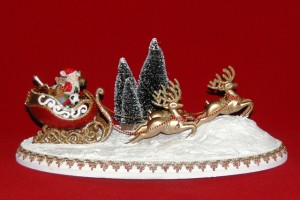 “People everywhere react in this way with regards to these items since most think that eggshell is too fragile to work with. However the eggs which I use today are provided by foreign farms who specialize in this sector where probably the birds are given food mixed with fragmented shells in order to harden the quality of their eggshells. This craft is so widespread in different countries that there are also factories which sell a variety of cleansed eggs.”
“People everywhere react in this way with regards to these items since most think that eggshell is too fragile to work with. However the eggs which I use today are provided by foreign farms who specialize in this sector where probably the birds are given food mixed with fragmented shells in order to harden the quality of their eggshells. This craft is so widespread in different countries that there are also factories which sell a variety of cleansed eggs.”Yet when Candice came over to Malta, she was quite shocked as there were no shops who sold the accessories needed for this work.
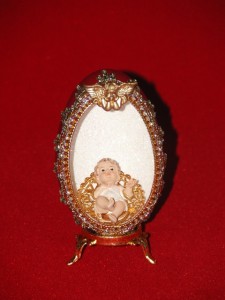 “This craft was totally unknown in Malta but with the help of my husband I searched on the internet and I succeeded to buy all that was necessary online. Egg decoration had become an essential part of my life and I simply could not stop creating new things. Initially I did these objects for my personal satisfaction. Then surprisingly, when I started to give them out as gifts, I began to receive requests from my friends to make something for them. Eventually I had so many finished objects and I saw so much interest in my work, that I decided to fulfill another dream of mine and I opened this shop.”
“This craft was totally unknown in Malta but with the help of my husband I searched on the internet and I succeeded to buy all that was necessary online. Egg decoration had become an essential part of my life and I simply could not stop creating new things. Initially I did these objects for my personal satisfaction. Then surprisingly, when I started to give them out as gifts, I began to receive requests from my friends to make something for them. Eventually I had so many finished objects and I saw so much interest in my work, that I decided to fulfill another dream of mine and I opened this shop.”A range of eggs of various sizes and colours were ready to be transformed into new creations. Likewise, small jars of colourful paint and a multitude of various decorations were crying out to become part of a new charming object.
“I’m always dreaming of what I can do next. I work with all sorts of eggs, starting with the smallest ones of love-birds and parrots, and moving on to larger ones such as those of pigeons, quails, ducks, geese, emu, rhea and ostrich. The geese’ eggs are the most practical because of their size and shape. Other eggs are relished for their natural particular characteristics such as the blackish colour of the rhea eggs and the large shape and pearly shade of the ostrich eggs.”
For the Christmas season, Candice has come up with exquisite original creations.
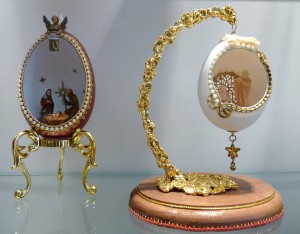 “Christmas time is wonderful and I love to reflect its warm sensations and meaning in my works. Cribs are the most requested although I have a vast selection of other items too. I’m constantly pondering over new creations as I thrive hard to provide unique hand-made objects which one could give to that special person who deserves such an exclusive gift.
“Christmas time is wonderful and I love to reflect its warm sensations and meaning in my works. Cribs are the most requested although I have a vast selection of other items too. I’m constantly pondering over new creations as I thrive hard to provide unique hand-made objects which one could give to that special person who deserves such an exclusive gift.Some clients have even asked me to show them how these creations are done in order to be able to produce them for themselves and also to compose their very own personal gift this Christmas. I instructed them how to do Christmas crackers first and many clients were delighted to see that even they could produce beautiful objects. For after all, it’s all a matter of creativity, dedication and much patience.”
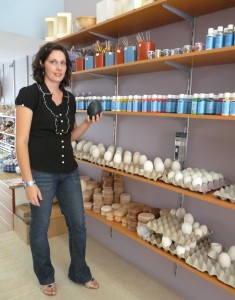 I asked her whether she was worried that these very clients would one day become her very competitors.
I asked her whether she was worried that these very clients would one day become her very competitors.“Probably some of them might but I have no problem with that. Instead I feel great satisfaction when I understand that I succeeded to initiate the love for this craft in these islands. For after all what is the value of such creativity if you can’t share it with others?”
(Note: An edited version of this article was published in FIRST Issue December 2011)
-
AKTAR MA NĦAFFER AKTAR INSIB
“Jiena għandi vantaġġ li ma nsuqx,” bdieli d-diskors l-personaġġ li kellimt dil-ġimgħa, Tony Terribile. “Għaldaqstant kull fejn immur ikolli nimxi u b’hekk insib aktar ċans biex nosserva mill-qrib it-toroq li nkun għaddej minnhom.”
Perspettiva interessanti! Personalment ma nistax nimmaġinani ma nsuqx u wisq inqas li nara dan bħala vantaġġ. Madanakollu fhimt sewwa x’ried ifisser bi kliemu u l-ftit ħin prezzjuż li għaddejt fil-kumpanija tiegħu, fetaħli orizzonti ġodda dwar kif nista’ napprezza iżjed it-toroq tagħna.
Umilment Tony jiddeskrivi lilu nnifsu bħala ‘dilettant ta’ dak kollu li hu Malti’. Imma ċertament huwa ħafna aktar minn hekk. L-imħabba tiegħu lejn l-istorja ta’ pajjiżu
 nebbħitu biex mhux biss jgħożż il-wirt storiku tagħna imma saħansitra biex b’inizjattiva personali jiġbor tagħrif siewi dwar l-għadd kbir ta’ teżori Maltin li forsi ħafna minna bilkemm nagħtu kashom. Fost xogħolijietu, laqgħatni l-ktieb tiegħu ‘Niċeċ u statwi fit-toroq Maltin’ li jikkonsisti f’ġabra ta’ informazzjoni u ritratti dwar in-niċeċ u l-istatwi li nsibu f’Malta.
nebbħitu biex mhux biss jgħożż il-wirt storiku tagħna imma saħansitra biex b’inizjattiva personali jiġbor tagħrif siewi dwar l-għadd kbir ta’ teżori Maltin li forsi ħafna minna bilkemm nagħtu kashom. Fost xogħolijietu, laqgħatni l-ktieb tiegħu ‘Niċeċ u statwi fit-toroq Maltin’ li jikkonsisti f’ġabra ta’ informazzjoni u ritratti dwar in-niċeċ u l-istatwi li nsibu f’Malta.“L-interess tiegħi f’dawn in-niċeċ u statwi beda madwar 40 sena ilu. Sakemm kont għadni żgħir kont noqgħod ninnota biss it-toroq varji f’Tas-Sliema fejn kont noqgħod. Meta mbagħad bdejt nitfarfar u bdejt noħroġ il-barra minn dawn l-inħawi, skoprejt kemm kien hemm aktar x’tara anki f’diversi postijiet oħrajn.
Darba minnhom ġietni f’rasi li naqbad il-kamera ċkejkna li kelli u nibda niġbed ir-ritratti tan-niċeċ u l-istatwi li niltaqa’ magħhom. Fuq kollox, meta kont immur lura d-dar, kont inniżżel id-dettalji tagħhom fostom: tat-triqat fejn jinsabu, id-dati u xi informazzjoni li jkun hemm imniżżla fuq il-plakek tagħhom u anki xi ġrajjiet li nkun smajt jew qrajt dwarhom.
Maż-żmien indunajt li kont sibt speċi ta’ teżor li iktar ma kont inħaffer fih, aktar kont insib oġġetti prezzjużi. Dak li kien beda biss bħala biċċa xogħol personali għall-interess
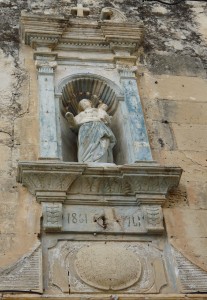 tiegħi biss tant kiber li deherli li kien dnub li ma naqsamx dak il-materjal kollu mal-oħrajn. U hekk twieled dan il-ktieb dwar in-niċeċ li jinsabu f’Malta. Ta’ min insemmi illi Patri Serafin Borg ippubblika ktieb simili dwar in-niċeċ li hemm fil-gżira t’Għawdex.”
tiegħi biss tant kiber li deherli li kien dnub li ma naqsamx dak il-materjal kollu mal-oħrajn. U hekk twieled dan il-ktieb dwar in-niċeċ li jinsabu f’Malta. Ta’ min insemmi illi Patri Serafin Borg ippubblika ktieb simili dwar in-niċeċ li hemm fil-gżira t’Għawdex.”Naturalment qabel iltqajt ma’ Tony ħadt ħsieb li nagħti daqqa t’għajn tajba lill-ktieb tiegħu. Intbaħt kemm akkost li ngħid
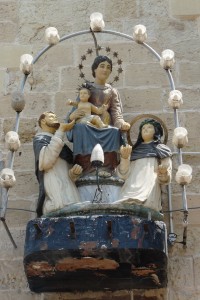 li nħobb tant il-patrimonju storiku Malti, kont għadni prattikament ma naf xejn dwar dan is-suġġett. Sakemm waslet il-ġurnata tal-laqgħa tagħna bdejt nimraħ aktar madwar in-niċeċ u l-istatwi li sibt fi triqati u b’hekk irnexxieli nikkonferma li f’pajjiżi letteralment kull kantuniera għandha storja x’tirrakkonta.
li nħobb tant il-patrimonju storiku Malti, kont għadni prattikament ma naf xejn dwar dan is-suġġett. Sakemm waslet il-ġurnata tal-laqgħa tagħna bdejt nimraħ aktar madwar in-niċeċ u l-istatwi li sibt fi triqati u b’hekk irnexxieli nikkonferma li f’pajjiżi letteralment kull kantuniera għandha storja x’tirrakkonta.“Kieku napprezzawhom it-toroq ta’ Malta huma mużew! Imma llum kulħadd bil-karozza u jibqa’ għaddej mgħaġġel u ma jara xejn.
Għalija dawn in-niċeċ u statwi huma monumenti żgħar ta’ mħabba. Kollha għandhom sinifikat u xi ġrajja marbuta magħhom tan-nies li ħadmu biex sawwruhom. Uħud minnhom huma xogħolijiet artistiċi maħduma mill-aqwa skulturi lokali. Oħrajn tant huma antiki li ftit li xejn nafu dwarhom u għalkemm hija evidenti l-id tajba li ħadmithom, ħadd ma jaf min għamilhom. Ħasra!”
Fil-fatt skont Tony waħda mill-eqdem niċeċ datati tmur lura sat-tmintax il-seklu.
“Tinsab l-Imdina fil-mina magħrufa bħala ‘Tal-Għarreqin’ u tikkonsisti f’riliev sabiħ tal-Madonna bil-Bambin. Hi niċċa devota ħafna u spiss tkun mixgħula u mżejna bil-fjuri.”
Bla dubju dawn ix-xogħolijiet huma xhieda tar-rabta tal-poplu mar-reliġjon tiegħu. Bosta minnhom huma kopji tal-istatwi titulari tal-post iżda mbagħad issib ukoll diversi
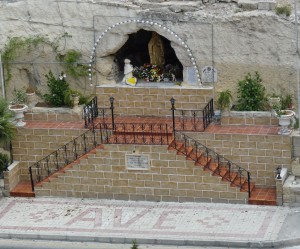 statwi li saru bħala radd ta’ ħajr kemm b’mod individwali u kif ukoll b’għaqda fost iċ-ċittadini tar-raħal jew belt.
statwi li saru bħala radd ta’ ħajr kemm b’mod individwali u kif ukoll b’għaqda fost iċ-ċittadini tar-raħal jew belt.“L-akbar ammont ta’ niċeċ huma dedikati lill-Madonna b’mod speċjali lil Santa Marija tal-Karmnu.
Fil-fatt l-aktar niċċa li għad għandha devozzjoni kbira sal-ġurnata ta’ llum hija n-niċċa mdaqqsa tal-Madonna ta’ Lourdes li tinsab fi Triq Diċembru XIII.
Nistgħu ngħidu li dawn in-niċeċ u l-istatwi nsibuhom f’kull belt u raħal ta’ gżiritna. L-aktar post miżgħud bihom huwa Ħal-Qormi fejn hemm madwar 200 biċċa xogħol. L-inqas wieħed huwa Ħal-Safi
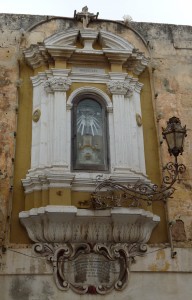 għalkemm meta tqis iċ-ċirkustanzi tal-post tara li xorta hemm ammont ta’ xogħolijiet konsiderevoli.
għalkemm meta tqis iċ-ċirkustanzi tal-post tara li xorta hemm ammont ta’ xogħolijiet konsiderevoli.In-niċeċ u l-istatwi tal-qaddis patrun jispikkaw. Però imbagħad ġieli ssib xogħolijiet ta’ qaddisin li ma jkunux daqshekk magħrufa u meta tfittex dwarhom ġeneralment issib li dawn ikunu saru fuq inizzjattiva personali.
Eżempju simili hija n-niċċa tal-Madonna tal-Grazzja li tinsab f’kantuniera bejn Triq is-Santwarju u Triq il-Kbira f’Ħaż-Żabbar. L-istatwa twaqqfet minn Vitor Caruana b’radd ta’ ħajr lill-Madonna talli nħeles mill-attakk li l-Franċiżi għamlu f’dan il-post fl-1798. Hija xogħol ta’ Mariano Gerada li kien skultur mill-iprem kemm fil-ġebla u anki fl-injam.”
Dawn ix-xogħolijiet ifakkru wkoll ċertu ġrajjiet li għadda minnhom pajjiżna. Fostom insibu għadd ta’ xbiehat li saru b’ringrazzjament mis-superstiti tal-marda qalila tal-pesta li ħakmet lil Malta fl-1813.
“Partikolarment f’Ħal-Qormi, fejn din il-marda ħalliet bosta vittmi, insibu numru ta’ niċeċ imwaqqfa f’ġieħ Santu Rokku li huwa l-qaddis patrun ta’ din il-marda. Madanakollu personalment naħseb illi
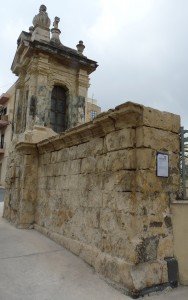 wieħed mill-aqwa monumenti li jfakkar daż-żmien hija l-istatwa ta’ San Bastjan, patrun ieħor tal-pesta. Din l-istatwa saret fl-1815 minn Ċikku u Gerolamo Fabri u qiegħda fil-bidu tal-istess raħal.
wieħed mill-aqwa monumenti li jfakkar daż-żmien hija l-istatwa ta’ San Bastjan, patrun ieħor tal-pesta. Din l-istatwa saret fl-1815 minn Ċikku u Gerolamo Fabri u qiegħda fil-bidu tal-istess raħal.Daqstant ieħor hija imprezzabbli n-niċċa li tinsab fl-inħawi tal-Infetti f’Birkirkara fejn l-isem innifsu jixhed illi f’dal-post kienu ġew midfuna l-vittmi tal-epidemija tal-pesta u l-kolera.
Fuq ton aktar pożittiv anki n-niċċa li tinsab fi Triq il-Vitorja fl-Isla tfakkar dan il-gwaj. Iżda did-darba x-xbieha magħrufa bħala l-Madonna tan-Nofs saret bħala ringrazzjament talli ħadd minn din il-belt ma kien intlaqat minn din il-marda qerrieda.”
Ma’ l-aktar niċeċ devoti wieħed kien isib ukoll numru ta’ indulġenzi.
“In-nies kienet titlob lill-Isqof biex isiru l-indulġenzi fuq l-aktar niċeċ li huma kellhom devozzjoni lejhom. L-indulġenzi kienu jikkonsistu f’talb li jsir quddiem dawn in-niċeċ
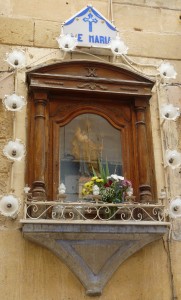 sabiex jinħafru l-pwieni mill-purgatorju. Mill-kitbiet li jinstabu fuq diversi niċeċ nafu illi dawn l-indulġenzi kienu għadhom jingħataw sas-snin ħamsin. Fil-fatt faċċata tal-Knisja ta’ Ħ’Attard insibu niċċa ta’ Santa Marija li ngħatawlha l-indulġenzi fl-1949.
sabiex jinħafru l-pwieni mill-purgatorju. Mill-kitbiet li jinstabu fuq diversi niċeċ nafu illi dawn l-indulġenzi kienu għadhom jingħataw sas-snin ħamsin. Fil-fatt faċċata tal-Knisja ta’ Ħ’Attard insibu niċċa ta’ Santa Marija li ngħatawlha l-indulġenzi fl-1949.F’nofs is-seklu d-devozzjoni tal-indulġenzi bdiet tmajna sakemm spiċċat għal kollox. Madanakollu permezz ta’ dawn il-kitbiet dwar l-għoti tal-indulġenzi lin-niċeċ, illum nistgħu nsiru nafu ż-żmien meta bejn wieħed u ieħor saru dawn ix-xbiehat.”
Ir-rakkonti marbuta ma’ dax-xogħolijiet huma kkuluriti u varjati ferm.
“Waħda min-niċeċ li kienu ferm devoti tinsab faċċata tal-ġnien pubbliku li jgħaqqad l-Imsida mal-inħawi tal-Pietà. Hija niċċa tad-Duluri li għalkemm mhiex xi waħda ta’ livell għoli artistiku fl-istess ħin
 tfakkarna fi ġrajja ħelwa ta’ mħabba ta’ personaġġ magħruf sewwa f’pajjiżna. Fil-fatt din in-niċċa twaqqfet mill-pittur famuż Giuseppe Calì wara li l-Madonna qalgħatlu l-grazzja li jiżżewweġ lil Perennia Pace; tfajla li kienet toqgħod proprju f’dak l-isqaq u li hu tilef għaqlu warajha. Ġewwa n-niċċa huwa poġġa pittura tad-Duluri li pinġa huwa stess u għal diversi snin kull min kien jgħaddi mill-inħawi, kien jieqaf jgħid Ave Marija quddiemha. F’dawn l-aħħar snin, minħabba raġunijiet ta’ sigurtà, il-pittura tneħħiet min-niċċa u tpoġġiet fil-parroċċa tal-Imsida.
tfakkarna fi ġrajja ħelwa ta’ mħabba ta’ personaġġ magħruf sewwa f’pajjiżna. Fil-fatt din in-niċċa twaqqfet mill-pittur famuż Giuseppe Calì wara li l-Madonna qalgħatlu l-grazzja li jiżżewweġ lil Perennia Pace; tfajla li kienet toqgħod proprju f’dak l-isqaq u li hu tilef għaqlu warajha. Ġewwa n-niċċa huwa poġġa pittura tad-Duluri li pinġa huwa stess u għal diversi snin kull min kien jgħaddi mill-inħawi, kien jieqaf jgħid Ave Marija quddiemha. F’dawn l-aħħar snin, minħabba raġunijiet ta’ sigurtà, il-pittura tneħħiet min-niċċa u tpoġġiet fil-parroċċa tal-Imsida.Eżempju ieħor hija l-istatwa ta’ San Ġiljan li tinsab fil-bajja ta’ San Ġiljan. Din l-istatwa tmur lura lejn l-ewwel nofs tas-seklu 19 u magħha hemm marbuta tradizzjoni qawwija u folkloristika li ġejja mill-imgħoddi. Snin ilu minn taħt din l-istatwa kienet tgħaddi nixxiegħa tal-ilma ġieri. L-ommijiet li kien ikollhom lil uliedhom morda kienu jeħduhom f’din in-nixxiegħa u wara jgħoddsuhom s’għonqhom fir-ramel. Sadanittant l-omm kienet tinxteħet f’riġlejn San Ġiljan u titolbu:
“Dak mhux ibni,
Bdiltuli.
Tfejjaqhuli
Jew inħallihulek f’wiċċek.”
Wara l-ilbies tat-tarbija kienu jinsarru u jindifnu fir-ramel u l-ħamrija għax kienu jemmnu li b’hekk il-marda tindifen magħhom għal dejjem. Din id-drawwa damet snin twal issir, tant li fl-1935 Sir Temi Zammit semmiegħa fil-ktieb tiegħu u żied jgħid li maż-żmien twieled qawl li kien jgħid “Mur indifen f’San Ġiljan”. Illum in-nixxiegħa għosfrot iżda l-istatwa ta’ San Ġiljan għadha wieqfa bħala tifkira tal-imgħoddi.”
Għalkemm bosta min-niċeċ u l-istawi huma maħduma mill-ġebla Maltija, jeżistu numru ieħor mnaqqxa fl-injam.
“Min ma kienx jiflaħ iħallas għax-xogħol tal-ġebel kien jordna n-niċeċ u l-istatwi tal-injam. Huma niċeċ sbieħ ferm però għandhom problema kbira: ma jservux daqs dawk tal-ġebel u għalhekk jeħtieġu aktar kura.
Bosta minn dawn ix-xbiehat tal-injam insibuhom fil-Kottonera u fil-parti t’isfel tal-Belt Valletta. Madanakollu nsibu uħud minnhom f’lokalitajiet oħra; waħda mill-eżempji ewlenin tinsab qrib l-Għajn tal-
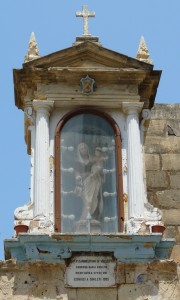 Ħasselin fi Triq il-Wied fl-Imsida. Fiha hemm meqjuma riliev sabiħ tal-Madonna tħaddan lil Ġesù mejjet fi ħdanha. Din hija waħda mill-isbaħ u mill-ikbar niċeċ tal-injam li għandna fi gżiritna u hi maħduma b’sengħa kbira.”
Ħasselin fi Triq il-Wied fl-Imsida. Fiha hemm meqjuma riliev sabiħ tal-Madonna tħaddan lil Ġesù mejjet fi ħdanha. Din hija waħda mill-isbaħ u mill-ikbar niċeċ tal-injam li għandna fi gżiritna u hi maħduma b’sengħa kbira.”Tony għarraffni illi kien hawn ħabta meta dawn in-niċeċ u l-istatwi bdew jinsterqu.
“Matul is-snin sirt naf dawn ix-xogħolijiet b’għajnejja magħluqa u għalhekk ninnota aktar meta togħsfor xi waħda minnhom. Niċċa tipika hija waħda ta’ San Nikola li kien hemm fi Triq is-Santwarju f’Ħaż-
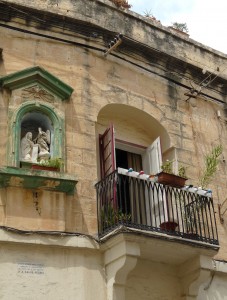 Żabbar u li ma nafx x’sar minnha! Lil xi niċeċ oħra insterqulhom il-fanali li kellhom quddiemhom jew il-grampuni li kienu mdawwrin bihom fejn dari kienu jitpoġġew it-tazzi taż-żejt sabiex jinxtegħlu fil-festa.
Żabbar u li ma nafx x’sar minnha! Lil xi niċeċ oħra insterqulhom il-fanali li kellhom quddiemhom jew il-grampuni li kienu mdawwrin bihom fejn dari kienu jitpoġġew it-tazzi taż-żejt sabiex jinxtegħlu fil-festa.Darba minnhom saħansitra spiċċajt il-Qorti fuq każ simili. Kont qiegħed ġewwa ħanut tal-antikitajiet u fost l-affarijiet li kellu, nilmaħ niċċa li kienet insterqet xi ftit tal-ġranet qabel minn raħal partikolari. Avżajt lill-Kunsill Lokali, sar rapport l-għassa u spiċċajt nixhed il-Qorti biex nikkonferma li dik kienet l-istess niċċa. Id-destin ried li xi snin qabel kont ħadtilha ritratt fil-post fejn kienet poġġuta u n-negattiva ta’ dak ir-ritratt intużat bħala prova.”
Xtaqt inkun naf mingħand Tony kif inhu l-istat in ġenerali ta’ dawn ix-xogħolijiet?
“Illum jeżisti ħafna interess dwar dawn in-niċeċ u statwi u bosta huma konxji tal-valur storiku tagħhom. Huma wkoll protetti mill-awtoritajiet u ħadd ma jista’ jċaqlaqhom minn posthom mingħajr permess.
Il-biċċa l-kbira tagħhom qegħdin fi stat mhux ħażin, oħrajn huma traskurati mmens filwaqt li numru minnhom intilfu għax insterqu u ħadd ma ta kas.
Forsi anki b’nuqqas ta’ għarfien ċertu niċeċ saritilhom il-ħsara meta nżebgħu peress li idealment dawn għandhom jitħallew kif kienu oriġinarjament. Infatti f’ċerti xogħolijiet li riċentement ġew restawrati, stajna naraw xi dettalji sbieħ li qabel kienu moħbija.
Jiena nagħfas fuq il-Kunsilli Lokali biex jaraw li dawn it-teżori storiċi tagħna jkunu protetti u apprezzati. Nemmen li xogħolijiet bħal dawn għad għandhom sinifikat qawwi u huma xhieda tal-valuri
 reliġjużi tal-poplu Malti. Naħseb illi kieku kellna nerġgħu ndaħħlu d-drawwa li jinbnew dawn in-niċeċ fil-qalba tal-blokok tal-appartamenti ġodda tagħna, xbiehat bħal dawn ikunu kapaċi joħolqu sens ta’ ġabra u għaqda fost in-nies tal-inħawi.”
reliġjużi tal-poplu Malti. Naħseb illi kieku kellna nerġgħu ndaħħlu d-drawwa li jinbnew dawn in-niċeċ fil-qalba tal-blokok tal-appartamenti ġodda tagħna, xbiehat bħal dawn ikunu kapaċi joħolqu sens ta’ ġabra u għaqda fost in-nies tal-inħawi.”Dan l-aħħar Tony Terribile qiegħed jagħti sehemu fi proġett ġdid li għandu l-iskop li jiġbor kemm jista’ jkun tagħrif dwar in-niċeċ u l-istatwi li fadal sabiex b’hekk dawn ikunu jistgħu jiġu protetti aħjar.
Barra minn hekk, proprju dax-xahar tħabbar illi s-Segretarjat Parlamentari responsabbli mill-Kunsilli Lokali qed jagħti għajnuna finanzjarja lil
 uħud mill-Kunsilli Lokali madwar Malta u Għawdex biex iwettqu proġetti u interventi ta’ restawr fuq numru ta’ xogħolijiet li fostom jinkludu dawn in-niċeċ u statwi antiki.
uħud mill-Kunsilli Lokali madwar Malta u Għawdex biex iwettqu proġetti u interventi ta’ restawr fuq numru ta’ xogħolijiet li fostom jinkludu dawn in-niċeċ u statwi antiki. Din l-aħbar fakkritni mill-ewwel f’niċċa antika ta’ San Spiridione li tinsab fi Triq il-Gardiel Marsaskala. Għal dawn l-aħħar erbgħa snin, din l-istatwa li nħadmet fl-1909 kienet
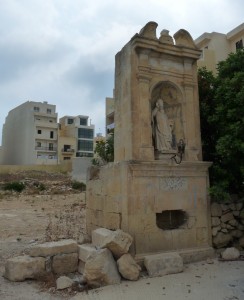 qegħdha fi stat imwiegħer peress li eżatt biswitha nbena blokk imdaqqas ta’ appartamenti kbar. B’xorti tajba meta kkuntattjajt lis-Sindku Mario Calleja, dan ikkonfermali illi l-Kunsill kien ser jirċievi fondi biex jibda xogħol ta’ restawr fuq xi niċeċ antiki u fostom fuq din in-niċċa partikolari. Nistqarr li nħossni tassew sodisfatta li finalment ser nara lil din in-niċċa titressaq f’post aktar sikur u xieraq fejn tista’ titgawda aktar minn kullħadd.
qegħdha fi stat imwiegħer peress li eżatt biswitha nbena blokk imdaqqas ta’ appartamenti kbar. B’xorti tajba meta kkuntattjajt lis-Sindku Mario Calleja, dan ikkonfermali illi l-Kunsill kien ser jirċievi fondi biex jibda xogħol ta’ restawr fuq xi niċeċ antiki u fostom fuq din in-niċċa partikolari. Nistqarr li nħossni tassew sodisfatta li finalment ser nara lil din in-niċċa titressaq f’post aktar sikur u xieraq fejn tista’ titgawda aktar minn kullħadd.(Nota: Dan l-artiklu ġie ppubblikat fit-Torċa tal-25 ta’ Lulju 2010)
-
IL-ĦAJJA BĦAL LOTTERIJA
“Illum, aktar minn qatt qabel, jeżisti l-bżonn li nitkellmu flimkien u li nisimgħu lil xulxin sabiex nifhmu aħjar kif inħarsu lejn id-dinja tagħna. Iċ-ċinema huwa l-aħjar mezz kif tista’ tagħmel dan.” Martin Scorsese
INTERVISTA:
RAMON MIZZI – Kittieb, Direttur, Co-producer u sound – ‘In the end’
ALEXIS MIZZI – Director of photography, Co-producer, camera u editing – ‘In the end’
PHILIP MIZZI – Attur prinċipali u Executive producer – ‘In the end’
Jgħidu li fid-dinja min jitwieled tond ma jmutx kwadru. Forsi veru, imma għallinqas nemmen li tista’ taħdem biżżejjed biex għallinqas jekk ma tmutx kwadru, almenu tmut ovali.
In-nies li jirnexxu fil-ħajja minn dejjem kienu għall-qalbi. B’mod speċjali nitpaxxa insir naf dwar dawk l-inividwi li bdew mix-xejn iżda għax emmnu fihom infushom u f’ħolmiethom, stinkaw u ħadmu sakemm waslu fejn xtaqu. Wisq probabbli jqanqalni l-aspett ta’ kif wieħed jisfida destinu u jittanta jmur aktar il-bogħod minn kemm id-dinja tkun ippjanat li tagħtih. Forsi għalhekk ukoll nikteb dawn l-artikli… L-ewwel nett għax nieħu pjaċir nagħti dik l-importanza li jixraqlu bniedem li jkun ħadem għal xi ħaġa f’ħajtu. U t-tieni biex nipprovoka u nħajjar lil dak jew lil dik li forsi għandhom ħolma f’ħajjithom imma għad m’għandhomx fiduċja biżżejjed li jistgħu jwettquha.
Din il-ġimgħa ser inlaqqagħkom ma’ ħabib tiegħi li hu wkoll kellu ħolma u li ftit ftit qiegħed jagħmilha realtà. Lil Ramon Mizzi iltqajt miegħu meta kont għadni naħdem il-
 bank. Ma ridtx ħafna biex nintebah li kellu karattru pjuttost insolitu u nistqarr li ftit naf bħalu. Bniedem deċiż li kelma jgħidilek, tieħux għalik jew le. Imma miegħu tkun taf fejn inti. Niftakru affaxxinat bil-kbir bl-attur Marlon Brando imma sakemm konna naħdmu flimkien, qatt ma smajtu jgħid li xtaq jaħdem fil-qasam tal-films. B’danakollu kont ċerta illi l-ambjent formali tal-bank fejn konna naħdmu, xejn ma kien jaqbel mal-personalità tiegħu. Ma stajtx nifhem x’ġibdu lejn dak ix-xogħol u fil-fatt wara ftit tas-snin ġietu x-xorti li jieħu s-somma u telaq.
bank. Ma ridtx ħafna biex nintebah li kellu karattru pjuttost insolitu u nistqarr li ftit naf bħalu. Bniedem deċiż li kelma jgħidilek, tieħux għalik jew le. Imma miegħu tkun taf fejn inti. Niftakru affaxxinat bil-kbir bl-attur Marlon Brando imma sakemm konna naħdmu flimkien, qatt ma smajtu jgħid li xtaq jaħdem fil-qasam tal-films. B’danakollu kont ċerta illi l-ambjent formali tal-bank fejn konna naħdmu, xejn ma kien jaqbel mal-personalità tiegħu. Ma stajtx nifhem x’ġibdu lejn dak ix-xogħol u fil-fatt wara ftit tas-snin ġietu x-xorti li jieħu s-somma u telaq.“Għoddejtu bħala t-tieni ċans f’ħajti sabiex nagħmel dak li veru nixtieq,” beda jgħidli hekk kif bdejna nfakkru lil xulxin dwar l-esperjenzi u l-memorji ta’ dak iż-żmien. “Meta kont il-bank bdejt inħoss ġibda lejn id-dinja taċ-ċinema. Niftakarni naħseb illi jekk xi darba nispiċċa minn dak ix-xogħol ma nerġax nidħol f’xogħol ieħor li ma jkunx għal qalbi. U nistgħu ngħidu li ġietni l-opportunità.
Meta konna żgħar, jiena u ħija konna naraw ħafna films kemm għax fil-familja nħobbuhom ħafna u speċjalment għax in-nannu kien jaħdem bħala projectionist taċ-ċinema. Sikwit kienu jiġuni ħafna ideat imma ma kontx naf kif ser nesprimihom jew niktibhom.
Għaldaqstant meta ħadt is-somma ddeċidejt illi flimkien ma’ ħija nidħol għal kors ta’ 4 snin fil-film-making f’Università fl-Awstralja – Middlesex School of Audio-Engineering. Kien kors utli ħafna fejn matulu ingħatajna taħriġ prattiku fuq il-kamera u kif neditjaw. Trawwimna wkoll kif nibnu skript li jiġbed l-udjenza, kif toħloq dawk it-‘twists and turns’ u kif karattru tagħtih dik ix-xi ħaġa li l-udjenza tkun tista’ tirrelata miegħu. Fostom laqtitni s-sengħa ta’ kif tibni l-profil tal-attur u s-sistema ta’ kif issawwarlu l-karattru matul il-vjaġġ tiegħu fil-film. Rajna wkoll kemm kien importanti illi lill-attur turih dan il-profil u mhux tħalli f’idejh biss u mbagħad tara wara biex ser joħroġ. Xi ħaġ’oħra li ftaħna għajnejna dwarha kien il-fatt li ridt tikteb skont ir-riżorsi li kellek f’idejk. Ngħidu aħna inutli tikteb dwar xeni ta’ karozzi jinqalbu u jisplodu meta m’għandikx il-finanzi biex tiġbed xeni bħal dawn. Finalment, meta ggradwajna, konna aktar preparati biex nibdew għalkemm konna konxji illi f’din l-industrija biex tirnexxi teħtieġ ħafna esperjenza.”
“Qabel jiena u ħija kellna xogħlijiet differenti,” kompla jispjegali Alexis. “Din kienet l-ewwel darba li konna qed nagħmlu xi ħaġa flimkien f’dan il-qasam. Il-faxxinu lejn il-film-making hija xi ħaġa komuni bejnietna. Jiena minn dejjem kelli dik il-ħeġġa li nirrakkonta l-istejjer, mhux permezz tal-kitba imma permezz tal-filming. Imma ma kontx naf kif isiru dawn l-affarijiet. Qabel dħalt għal dal-kors kont naħseb illi film isir billi wieħed jagħmel reċta u mbagħad jibda jiġbed biċċa u jieqaf, wara jiġbed biċċa oħra u jerġa’ jieqaf sakemm finalment ipoġġi kollox flimkien u jsir il-film. Ma kelli l-ebda idea tal-editing!”
Wara li lestew dan il-kors Ramon u Alexis irritornaw lura f’Malta. Hawnhekk huma ħadmu bħala għalliema fl-MCast u aktar tard kienu responsabbli mir-restawr tal-arkivji tal-PBS.
“Bdejna nirrestawraw ix-xogħol tat-tertuqa fl-arkivji li kienu jkopru filmati mill-1964 sa l-1981. Ftit wara beda jittella’ programm bi skop edukattiv fuq TVM bl-isem ta’ TV Education. Matulu aħna kellna nippreżentaw filmati qosra ta’ 5 minuti kollox b’materjal li konna nsibu mill-arkivji kif finalment kien iġib l-isem tal-progamm – ‘Mill-Arkivji’.
Fid-dinja llum, speċjalment fl-Ewropa, hemm sistema ta’ servers u hard drives fejn inti tista’ tiddiġitalizza l-antik f’format modern ħalli ma tħallix filmati preċedenti jintilfu. Sfortunatament fil-passat mhux dejjem kellhom il-futur f’moħħhom u ċertu materjal li kienu jaħdmu bih ma kienx jiflaħ għal tul ta’ snin. Konsegwentement intilfu ħafna rikordji mprezzabbli madwar id-dinja kollha. L-arkivji huma storja ta’ nazzjon u ta’ kultura. Hi x’inhi, jekk hiex aħbar, jekk hiex drama jew xi show televiżiva, kollha jiffurmaw l-istorja ta’ dak il-pajjiż u l-kultura tiegħu.”
“Konna nsibu ħafna stejjer interessanti,” kompla jispjegali Alexis. “Ġieli konna ntellgħu xi aħbar antika bħal meta kien waqa’ l-ajruplan Vulcan fuq Ħaż-Żabbar; filmat li lili affaxxinani ferm peress li lanqas biss kont naf li qatt sar inċident hekk. Ironikament wara li ħarġu dawn il-filmati missieri qalli li kienu ħaduni hemm dakinhar tal-inċident imma peress li kont għadni żgħir insejt kollox.”
“Niftakar darba sibna programm tas-snin sebgħin ‘Malta u lil hinn minnha’ li kien jagħmel Charles Abela Mizzi,” daħal ikompli Ramon. “Fih kien hemm l-aħbar ta’ meta kien sploda tanker taż-żejt fil-Libja u kienu mietu erbgħa Maltin u żewġ Ingliżi. Urejnieh fuq it-TV bl-inqas ħsieb imma l-għada li ntwera tgħidx kemm ċemplulna nies il-biċċa l-kbira familjari tagħhom. Għalija kien mument veru emozzjonali. Intbaħt kemm wara kollox b’xogħol bħal dan tkun qed tagħti servizz lill-poplu.”
“Lili taf x’impressjonani l-aktar?” introduċa ruħu fid-diskursata Philip (li jiġi missier Ramon u Alexis), “meta ġabu lill-Għawdxin sejrin lejn l-Awstralja. Kienu qed jintervistawhom. Staqsewhom fejn sejrin u x’kien beħsiebhom jagħmlu hemm? Kienu kollha lebsin puliti bil-ġlekk u l-ingravata, qishom sejrin għal xi tieġ. Kien hemm wieħed qal “Ma nafx imma hawn naħdem fil-ġebel kont jien.” Illum li għaddew is-snin u naf minn xiex għaddew dan-nies, inħoss ħafna meta nara filmati bħal dawn.”
F’Lulju tal-2008 huma pparteċipaw bil-film li nħadem għat-teżi biex iggradwaw ‘Moving On’ fin-National Film Competition tal-Malta Cine Circle. Rebħu tliet awards għalih: Best Production, Best Director u Best Use of Sound.
Id-diskussjoni ma damitx ma daret fuq ix-short film ‘In the end’ li pproduċew Ramon u Alexis fl-2009. Fi Frar ta’ dis-sena huma telgħu Los Angeles biex jiġbru l-award internazzjonali li rebħu għalih fit-taqsima tal-Best International Contemporary Short f’kompetizzjoni mnhedija waqt in-New York International Independent Film and Video Festival.
“Qatt ma ħsibna li ser naslu s’hawn u naturalment inħossuna kuntenti ħafna li xogħolna ġie apprezzat tant! Konna naqra kwieti u ddeċidejna li ntellgħu short film. Konna naħdmu fuqu matul il-weekends.
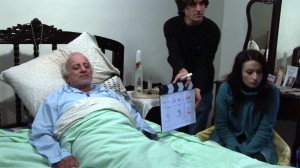 Bdejna fi Frar 2009 u lestejna f’Ġunju tal-istess sena. Sakemm inħadem ma kellniex xi pjanijiet kbar dwaru imma mbagħad kif rajna l-prodott lest l-istorja kienet differenti. Bgħatna l-film f’diversi postijiet fostom anki l-Amerika. Kien hemm fejn ġie aċċettat u kien hemm fejn ġie injorat. Fil-fatt bil-film ‘In the end’ konna anki pparteċipajna fi programm li kien qed jippromwovi s-short films fuq stazzjon Malti imma hemmhekk ma tantx għamel ħoss. F’Lulju mbagħad ipparteċipajna fin-National Film Competition mnhedija mill-Malta Cine Circle fejn il-film innifsu ma rebaħ xejn filwaqt li missieri rebaħ il-premju tal-Best Performance bħala l-attur prinċipali.
Bdejna fi Frar 2009 u lestejna f’Ġunju tal-istess sena. Sakemm inħadem ma kellniex xi pjanijiet kbar dwaru imma mbagħad kif rajna l-prodott lest l-istorja kienet differenti. Bgħatna l-film f’diversi postijiet fostom anki l-Amerika. Kien hemm fejn ġie aċċettat u kien hemm fejn ġie injorat. Fil-fatt bil-film ‘In the end’ konna anki pparteċipajna fi programm li kien qed jippromwovi s-short films fuq stazzjon Malti imma hemmhekk ma tantx għamel ħoss. F’Lulju mbagħad ipparteċipajna fin-National Film Competition mnhedija mill-Malta Cine Circle fejn il-film innifsu ma rebaħ xejn filwaqt li missieri rebaħ il-premju tal-Best Performance bħala l-attur prinċipali.Il-festival li rbaħna b’ ‘In the end’ huwa wieħed mill-akbar festivals indipendenti li jagħtu importanza kbira lix-short films, feature films u dokumentarji. Ħadna sehem fih meta issuġġerihulna ħabib tagħna minn New Zealand li hu direttur tal-fotografija. Kif għedtlek, ma konna qed nistennew xejn kbir imma f’daqqa waħda bdew jiġru ħafna affarijiet.
Aħna bgħatna l-film f’Ġunju 2009 billi tellgħajnih fuq il-YouTube. Xahar wara ċempluli biex inħallsu applikazzjoni ta’ parteċipazzjoni fil-festival peress li l-film kien ġie aċċettat biex jieħu sehem b’mod formali. F’Awwissu rċevejt email fejn għarrfuni illi ‘In the end’ kien ġie magħżul uffiċċjalment. Anki s’hemm għalina kien diġa’ unur kbir u nistqarr miegħek illi qisna nsejnih xi ftit meta beda għaddej iż-żmien. F’Ottubru reġgħu kkuntattjawni peress li xtaquna nitilgħu New York ħalli nkunu preżenti għall-wiri tiegħu fis-swali taċ-ċinema. Imma kemm peress li konna qegħdin nistudjaw il-Masters u aktar u aktar għax ma kellnix finanzi, ma tlajnix. Sadanittant il-film tagħna kien qiegħed jieħu sehem f’selezzjoni oħra fejn għal għaxart ijiem kuljum kienu qed jintwerew ammont ta’ films internazzjonali sabiex l-udjenza tagħżel l-aħjar tnejn minnhom. Fl-aħħar ġurnata kellhom jintwerew il-films kollha li ntagħżlu u minn hemm joħroġ ir-rebbieħ. Meta waslet l-aħħar email biex tinfurmana li l-film tagħna kien rebaħ award internazzjonali, bilkemm ridna nemmnu. U ċċekkjajna għal darba tnejn biex nikkonfermaw li kien minnu.”
‘In the end’ huwa film ta’ madwar 10 minuti. Jitratta l-istorja ta’ Paul, raġel anzjan li jgħix waħdu u li qed ibati mill-kundizzjoni tal-Alzheimer’s. Xtaqt inkun naf kif ġiet l-idea lil Ramon li jikteb dan l-iskript?
“L-ispirazzjoni għal din l-istorja ġietni meta kien qed imut in-nannu tiegħi, missier ommi. Dawk huma familja kbira u meta saret evidenti li n-nannu kien ser imut, kulħadd dar miegħu. Kont qed inħares
 lejn dix-xena meta għaddieli l-ħsieb “ara naqra, x’familja għandu ddur bih!” U mbagħad komplejt nistaqsi “Tgħid la nikber bħalu, inkun hekk jien? Għedt ma naħsibx”. U minn hemm bdiet l-idea dwar dan ir-raġel anzjan illi fuq is-sodda tal-mewt tiegħu qiegħed jhewden dwar ħajtu l-imgħoddija filwaqt li beda jistaqsi li kieku għex mod ieħor, x’kien jinbidel minn dawk il-mumenti li kien għaddej minnhom? Peress li l-anzjan kellu l-kundizzjoni tal-Alzheimer’s, ħsibijietu ġew b’saħħithom ħafna tant li saru aktar sodi u reali.”
lejn dix-xena meta għaddieli l-ħsieb “ara naqra, x’familja għandu ddur bih!” U mbagħad komplejt nistaqsi “Tgħid la nikber bħalu, inkun hekk jien? Għedt ma naħsibx”. U minn hemm bdiet l-idea dwar dan ir-raġel anzjan illi fuq is-sodda tal-mewt tiegħu qiegħed jhewden dwar ħajtu l-imgħoddija filwaqt li beda jistaqsi li kieku għex mod ieħor, x’kien jinbidel minn dawk il-mumenti li kien għaddej minnhom? Peress li l-anzjan kellu l-kundizzjoni tal-Alzheimer’s, ħsibijietu ġew b’saħħithom ħafna tant li saru aktar sodi u reali.”Philip ħadem il-parti ta’ Paul. Kif ħejja ruħu għal karattru hekk?
“Jiena rajt lil missieri jmut bl-Alzheimer’s għalkemm dak iż-żmien lanqas biss kont naf. Ma kienx muġugħ imma rajtu jidbiel ftit ftit kuljum. Ħassejtni sodisfatt li rnexxieli nwassal dak li jgħaddi minnu bniedem li jbati minn dil-kundizzjoni. Fil-fatt il-film trid tarah aktar minn darba biex tifhem sewwa d-dettalji u l-messaġġi kollha li fih.”
X’messaġġ xtaqtu twasslu permezz ta’ dan il-film?
“Minn riċerka li għamilna skoprejna illi l-kundizzjoni tal-Alzheimer’s hija problema kbira ħafna fl-Amerika. M’għandnix dubju illi dan kien wieħed mill-fatturi għala rebaħ ‘In the end’ peress li l-udjenzi setgħu jirrelataw miegħu faċilment.
Kif kulħadd jaf, fl-Amerika hemm problema kbira bid-distanza u għalhekk xtaqna illi min jara dan il-film jiftakar fl-anzjani tiegħu u jekk dawn jinsabu weħidhom jagħmlu daqsxejn sforz biex jagħmlu kuntatt magħhom jew jagħtuhom ftit għajnuna.”
Akkost li kemm Ramon u kemm Alexis jidhru li għalissa ma jixtiequx irabbu għeruq ma’ xi tfajla, in-namra fil-qasam tal-film-making qed tiżdied bil-bosta. Fil-fatt dan l-aħħar huma reġgħu telqu kollox minn idejhom sabiex jiffukaw fuq Masters in TV and Interactive Content, din id-darba fl-Università ta’ Birmingham City fl-Ingilterra.
“Iva ddeċidejna li nagħmlu l-Masters flimkien speċjalment għax irrealizzajna li naħdmu tajjeb ħafna bħala tim. L-idea ġiet għax xtaqna li jkollna aktar taħriġ f’dan il-qasam. Barra minn hekk qed nittamaw li niltaqgħu ma’ xi ħadd fl-Ingilterra li miegħu nistgħu nkabbru dan it-tim. Iżda s’issa għadha ma seħħitx din il-biċċa xogħol kemm għax fl-Ingilterra n-nies spiss joqogħdu ġewwa minħabba t-temp u anki għax il-post fejn qegħdin huwa kemmxejn għali u peress li aħna studenti nżommu naqra lura mill-ħruġ biex nevitaw spejjeż żejda,” fehemni Alexis.
It-taħriġ li qed nieħdu bħalissa huwa tajjeb ħafna. Fostom qed naraw kif għandek tibni kontenut għal dokumentarji televiżivi bħal dawk li kapaċi joffru ir-RAI, il-BBC u n-National Geographic. Inzerta li d-dokumentarji minn dejjem kienu jinteressawni u hawnhekk qed nitkissru fuq stil differenti minn dak li mdorrijin soltu naraw f’pajjiżna. Tolqotni s-sistema kif ma tużax biss id-dati imma tagħfas iktar fuq l-istorja u l-ħajja ta’ dawk li tkun qed titkellem dwarhom.”
Hemm xi film-maker li jispirahom?
Ramon irrispondini mill-ewwel “Kathryn Bigelow li għamlet il-film ‘The Hurt Locker’. Ammirajtha għax kienet l-ewwel mara li rebħet l-Oscar bħala film-maker u b’hekk irnexxielha tkisser id-drawwa ta’ industrija ġeneralment orjentata lejn l-irġiel.”
Lil Alexis jispiraħ “Martin Scorcese l-aktar minħabba l-mod ta’ kif jibni drama u kif jirrakkonta l-istorja, kif jiġbidha u jeditja. Joħloq ukoll ħafna karattri u stejjer interessanti. Bħalissa qed jiġuni f’moħħi l-films ‘Cape Fear’, ‘Taxi Driver’ u ‘Shutter Island.”
Bħala attur lil Philip jogħġbu “Al Pacino għax il-karattri li jaħdem huma kollha ‘nies ta’ veru’.”
Ma stajtx ma napprezzax is-sinerġija bejn dan il-missier u ż-żewġ uliedu li bejniethom it-tlieta jagħmlu kuraġġ lil xulxin sabiex ikomplu joħolqu proġetti ġodda. Madanakollu Philip stqarr miegħi illi f’żogħżitu huwa ma kienx sab din l-għajnuna…
“Kif qalulek uliedi aħna ġejjin minn familja li ilha ntiża fil-qasam tal-films. Fi żmienu nannuwi Francis Mizzi, kien intebaħ bil-potenzjalità li kellu ċ-ċinema f’Malta. Għalhekk bena żewġ talksijiet; wieħed
 f’Ħal-Luqa u l-ieħor f’Ħal-Qormi magħruf bħala ‘Il-Warner’. Terġa’ missieru kellu wkoll ċinema ieħor f’Ħal-Qormi li kien jismu s-‘St George’s’ fejn illum hemm il-Każin tal-Labour. Missieri kien jaħdem bħala projectionist u meta żżewweġ lil ommi din kienet tqatta’ ħafna ħin ħdejh. Għalhekk kienet tgħidli illi jien kont ilni nara l-films sa minn qabel twelidt għax anki meta kienet tqila baqgħet tmur sikwit. Meta mbagħad kbirt ftit, kont noqgħod ħdejn missieri fuq banketta nsegwi l-films. Tant kont nintilef li ġieli għamilt pipi taħti biex ma nitlifx xi biċċa u ommi tgħidx kemm kienet tirrabja!
f’Ħal-Luqa u l-ieħor f’Ħal-Qormi magħruf bħala ‘Il-Warner’. Terġa’ missieru kellu wkoll ċinema ieħor f’Ħal-Qormi li kien jismu s-‘St George’s’ fejn illum hemm il-Każin tal-Labour. Missieri kien jaħdem bħala projectionist u meta żżewweġ lil ommi din kienet tqatta’ ħafna ħin ħdejh. Għalhekk kienet tgħidli illi jien kont ilni nara l-films sa minn qabel twelidt għax anki meta kienet tqila baqgħet tmur sikwit. Meta mbagħad kbirt ftit, kont noqgħod ħdejn missieri fuq banketta nsegwi l-films. Tant kont nintilef li ġieli għamilt pipi taħti biex ma nitlifx xi biċċa u ommi tgħidx kemm kienet tirrabja!Ġiet naturali l-ħajra li nsir attur imma l-ironija hija illi missieri qatt ma aċċetta din ix-xewqa tiegħi! Dak iż-żmien fil-‘Warner’ kienu jiġu ħafna artisti Taljani biex jagħmlu l-cabaret shows. Kienu jgħixu ħajja ta’ ħallat u aqsam. Ma kien ikollhom diċenza ta’ xejn u ovvjament missieri kellu impressjoni ħażina ħafna tal-atturi. Kif spiċċajt mill-Liceo u bdejt it-teatru hu qalli “Se nibdew? Ara għamel din u ieqaf.” Kien għalxejn li qgħadt ingerger u neqred għax missieri kien deċiż tant li heddidni li jitfagħni ’l barra mid-dar jekk insostni. Kelli nċedi iżda wara li twieldu ż-żewġt itfal tiegħi attendejt fl-iskola tad-drama u llum ilni 33 sena naħdem fit-teatru.”
Meta staqsejtu liema rwoli li ħadem kienu l-aktar għal qalbu ma damx jaħsibha…
“Ovvjament il-parti ta’ Paul f’‘In the end’. Għoġobni għax kellu karattru kumpless ħafna. Waqt il-filming kont ninqata’ għalija sabiex nidħol fil-karattru. Min jaf kemm il-darba bqajt waħdi fis-sodda, anki meta l-oħrajn kienu jieqfu għall-brejk, ħalli ma nitlifx il-konċentrazzjoni.
Għall-qalbi ħafna wkoll hija l-parti ta’ miġnun li kont ħdimt fil-play Marat-Sade li l-istorja tagħha titkellem dwar il-qtil tal-Markiż de Sade. Interessanti huwa l-fatt illi dan Sade kien kittieb kontroversjali li qatta’ madwar 32 sena minn ħajtu magħluq fil-ħabsijiet u fil-manikomji. Il-kelma ‘sadiżmu’ oriġinat minn kunjomu proprju minħabba l-ħajja li kien jgħix u anki għal kitbietu fejn fostom esiġa illi l-atturi ta’ Marat-Sade kellhom ikunu kollha nies mill-manikomju. Kienet play diffiċli imma kellna rispons tajjeb ħafna dwarha.”
Ma’ Philip il-kliem waqa’ mill-ġdid dwar il-film li ħadmu wliedu fejn fostom saħaq illi f’pajjiżna hawn nuqqas kbir ta’ sapport fejn tidħol il-kultura.
“Hawnhekk trid tibda mix-xejn, il-motivazzjoni tiegħek biss trid tmexxik. M’hemm imkien fejn il-film-makers jistgħu jiltaqgħu u jagħmlu naqra kuraġġ lil xulxin. Biex għamilna dan il-film u saħansitra meta morna niġbru l-award kellna niffinanzjaw kollox aħna. Meta ċċekkjajna jekk stajnix nieħdu xi għajnuna finanzjarja biex inkomplu b’dan ix-xogħol infurmawna illi m’hawn l-ebda fondi dedikati għax-short films. L-affarijiet biex isiru tajjeb iridu l-flus, aktar u aktar jekk irridu nikkompetu ma’ xogħolijiet barranin fejn dal-qasam huwa ħafna aktar stmat.”
Dort mill-ġdid fuq Ramon u Alexis u xtaqt inkun naf jekk hux diffiċli li tirnexxi f’din l-industrija u jekk tagħmilx differenza li huma Maltin.
It-tnejn qablu illi “L-aktar importanti huma l-kuntatti, it-talent u x-xorti. Trid tinzerta fil-post it-tajjeb, fil-ħin opportun u tiltaqa’ mal-persuni ġusti. Jeħtieġ li tieħu l-ħajja bħal lotterija – aktar ma tixtri u tilgħab biljetti, aktar iżżid iċ-ċans li tirbaħ xi darba.
Ma jidhrilnix li tagħmel differenza li aħna Maltin. Illum bl-internet tilħaq ħafna nies kullimkien. F’din l-industrija aktar naħsbu illi s-sigriet hu kemm inti kapaċi li tipprovoka l-udjenza tiegħek b’ideat ġodda u b’oriġinalità f’xogħolok. Meta konna żgħar konna tgħallimna ħafna stejjer fostom dawk ta’ Dick Whittington u ta’ Cindirella. It-tnejn irnexxew fl-aħħar tar-rakkont għalkemm l-istejjer tagħhom kienu differenti. Whittington tħabat u stinka biex wasal fejn ried mentri Cindirella ġieta tajba u barra minn hekk kellha lil fairy godmother! Il-ħajja reali tixbaħ ħafna lil dawn l-istejjer.”
Bejn kafè u ieħor il-ħin kien sar sew. Kien għad fadalli kurżità waħda – x’kien l-akbar proġett li xtaqu jagħmlu?
Philip kien dirett, “Aktar milli proġett nixtieq li mqar għal darba t-teatru jagħti l-kreditu fejn jixraq!”
Ix-xewqa ta’ Alexis hi, “Li noħroġ b’idea oriġinali għal feature film ħalli eventwalment nirbaħ l-Oscar! Kbira żżejjed hux? Imma fid-dinja ma tridx taqta qalbek!”
Ħallejt lil Ramon jagħlaq id-diskursata, “Li naħdem feature film ibbażat fuq il-kultura Maltija. Fil-preżent dan il-qasam hu bbumbardjat bil-kultura Amerikana. Tkun interessanti kieku. Issa kemm naħseb li dan huwa possibbli? Jiddependi kemm ser tidħakli x-xorti!”
Il-film ‘In the end’ jinsab fuq il-link: http://www.youtube.com/watch?v=MFmkmhukB98 .
(Dan l-artiklu ġie ppubblikat fit-Torċa tat-18 t’April 2010)
Travelogue
Archives
| M | T | W | T | F | S | S |
|---|---|---|---|---|---|---|
| « Jan | ||||||
| 1 | 2 | 3 | 4 | 5 | 6 | 7 |
| 8 | 9 | 10 | 11 | 12 | 13 | 14 |
| 15 | 16 | 17 | 18 | 19 | 20 | 21 |
| 22 | 23 | 24 | 25 | 26 | 27 | 28 |
| 29 | 30 | |||||
Recent Posts
- A MATTER OF FATE
- MALTA’S PREHISTORIC TREASURES
- THE MAGIC IS IN THE DETAIL
- THE SELLING GAME
- NEVER FORGOTTEN
- Ġrajjiet mhux mitmuma – 35 sena mit-Traġedja tal-Patrol Boat C23
- AN UNEXPECTED VISIT
- THE SISTERS OF THE CRIB
Comments
- Pauline Harkins on Novella – Li kieku stajt!
- admin on IL-KARNIVAL TRAĠIKU TAL-1823
- Albert on IL-KARNIVAL TRAĠIKU TAL-1823
- Martin Ratcliffe on Love in the time of war
- admin on 24 SENA ILU: IT-TRAĠEDJA TAL-PATROL BOAT C23

